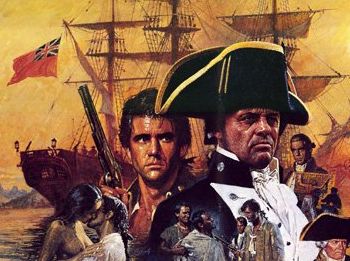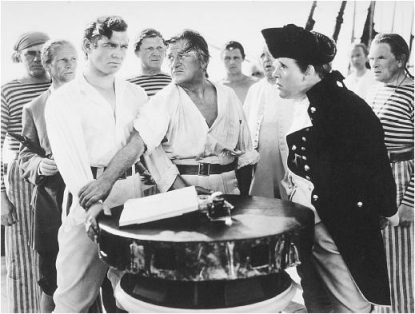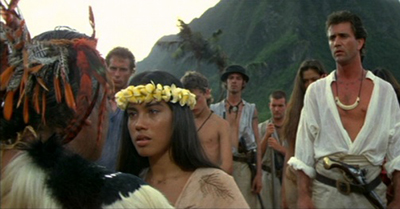The true story of the mutiny on the Bounty is not the romantic story that you've heard.
William Bligh Fletcher Christian.
Two men,
who
used to be friends,
became mortal enemies.

November, 1787
While commonly called the HMS Bounty, (His Majesty's Ship),
the correct name was HMAV Bounty.
There were small cannons on the ship, making it an 'armed vessel'.
The Bounty was the smallest
ship
William Bligh would ever command.
It had a very small crew of only 46 men.
He was officially a lieutenant, working for half the pay of a captain.
(And that was the
source of some of the problems).
The men could call him Captain out of respect.
William Bligh was 33 years old.

One of the crewmen had sailed
on an
earlier voyage with Bligh.
They both respected the other.
The
crewman had spoken highly of
Bligh as a commander.
Bligh recommended him for the new voyage and genuinely liked him.
The crewman had visited the
Bligh's home and
had 'danced Bligh's children on his knee'.
That crewman's name...
was Fletcher Christian.
The physical description of
Fletcher Christian sounds like he really
did look like actor Clark Gable.
Here is a scene from the
1935 film with Charles Laughton as Captain William Bligh
and Clark Gable as Fletcher Christian.

October 26, 1788, the Bounty arrived at Tahiti.
Because of frustrating delays and a failure to
get around the tip of South America
(the short way), the ship had sailed 28,000 miles.
Arriving too late in the season, it was
forced to remain in Tahiti
much longer than planned.
The men fell in love with the Tahitian women and with Tahiti itself.
.
Captain Bligh would later write that the reason for the mutiny was the men wanted to get back to the women on Tahiti.
April 4, 1789
Captain Bligh, Fletcher Christian and the crew, after
five months
on Tahiti, departed the Island with 1015 breadfruit plants.
Mutiny! April 28th, 1789
At 5 AM, Bligh is asleep in his small cabin. His door was open, as it had been throughout the voyage.
Suddenly, Fletcher Christian and other men grab Bligh, tying his hands behind him.
He is led past men with firearms and swords
and taken to the deck.
Bligh said, "Mr. Christian. You have danced my children on your knee".
Fletcher Christian
repeatedly said, "I have been in Hell. I have been in Hell."
Captain Bligh did indeed act
irrationally when the boat left Tahiti.
But they had spent over
five months on that Island.
He just wanted to get home
to his wife and daughters.
Sailors knew that life on a boat was hard. They knew that mutiny was
punished by hanging.
All they had to do was return to England, pick up their back pay and be free to do whatever they
wished, including
returning to Tahiti.
But a number of them chose to let one man do their thinking...
He was the most popular man on the boat,
but Fletcher Christian was mentally unstable.
How many of you knew that Fletcher seriously considered building a raft and floating away?
He was not thinking clearly; he was actually suicidal.
Months later, many of the mutineers hated him for
talking them into a mutiny.
Bligh and 18 other men were forced into a small craft that was
just 8 inches above the water line.
They were given provisions but it must have been assumed... that they would all die.
They began a 3618 mile journey, which took 49 days.
Somehow, with the loss of only one man, they succeeded.
Bligh returned to England as a hero.
Here's the bottom line on the truth about
the mutiny on the Bounty.
William Bligh had proven himself as a great seaman, but later...
he would see his name and reputation destroyed.
One of the crew members, Peter Heywood,
had a very influential family.
His family and Fletcher's family convinced the newspapers and public that
Captain Bligh
was a madman and the crew were forced to mutiny.
Bligh's reputation was tarnished badly.
He was despised.
A myth about Fletcher and the mutineers began to be accepted as fact.
Hollywood never told the true story,
because the myth was the romantic saga of heroes that we all want.
After the mutiny,
the Bounty did not go directly to Tahiti.
The mutineers went to the Island of Tubuai.
There is a major story concerning the
mutineers
and this Island.
However, because of time constraints and controversy, the movies have never shown this.
The natives on Tabuai did not like these newcomers and there was serious fighting.
Over 80 natives would die.
When the Bounty returned to
Tahiti for the final time,
the truth about the mutiny was discovered...
and the Tahitian people were outraged.
The movies always got it wrong.
The most popular film of 1935 was
'The Mutiny on the Bounty',
starring Clark Gable and Charles Laughton.
In 1962, Trevor Howard appeared
as Captain William Bligh,
opposite Marlon Brando in the Fletcher Christian role,
in the most
expensive rendition of the story. The film went millions over budget.
Absolutely the most historically accurate was the
1984 film 'The Bounty',
starring Mel Gibson and Anthony Hopkins.
Regardless, the story that these films depicted was completely wrong.
Captain Bligh was not a madman.
He treated his crews
better than most British Captains.
And Fletcher Christian... was not a hero.

Here's a scene from the Mel Gibson and Anthony Hopkins film, 'The Bounty'.
It's far and away more accurate than any of the other films.
Also in the cast were a couple of unknown actors named
Daniel Day-Lewis and Liam Neeson.
Mel Gibson described Fletcher Christian.
"He was a 24 year
old kid, and he was acting like one."
The scene depicted above never happened...
When they made their final visit to Tahiti,
Fletcher Christian did not get off the boat.
Many of the Tahitians who went to Pitcairn with the mutineers... were kidnapped!
The Bounty departed Tahiti on September 23, 1789, with 9 mutineers.
(16 others, some who had participated in the mutiny and some who had not,
elected to stay on Tahiti and take their chances).
On board the Bounty now were twelve Tahitian
women and six Tahitian men.
Do the math; you can see that there will be a problem.
There were more
men than women.
They arrived at Pitcairn Island on January 15th, 1790.
That's when things went really bad...
I invite you to read my book from Amazon.
Forget about what you've seen in the movies.
This is the absolutely true story.
Voyage to Hell!
A new look... at
the mutiny on the Bounty
Return to History and Mysteries
Main Page
Here is a scene from the 1935 film with Charles Laughton as Captain William Bligh and Clark Gable as Fletcher Christian.

Arriving too late in the season, it was forced to remain in Tahiti much longer than planned.
The men fell in love with the Tahitian women and with Tahiti itself.
.
Captain Bligh would later write that the reason for the mutiny was the men wanted to get back to the women on Tahiti.
Suddenly, Fletcher Christian and other men grab Bligh, tying his hands behind him.
He is led past men with firearms and swords and taken to the deck.
Bligh said, "Mr. Christian. You have danced my children on your knee".
Fletcher Christian repeatedly said, "I have been in Hell. I have been in Hell."
Captain Bligh did indeed act irrationally when the boat left Tahiti.
But they had spent over five months on that Island.
He just wanted to get home to his wife and daughters.
All they had to do was return to England, pick up their back pay and be free to do whatever they wished, including returning to Tahiti.
But a number of them chose to let one man do their thinking...
but Fletcher Christian was mentally unstable.
He was not thinking clearly; he was actually suicidal.
Months later, many of the mutineers hated him for talking them into a mutiny.
They were given provisions but it must have been assumed... that they would all die.
They began a 3618 mile journey, which took 49 days.
Somehow, with the loss of only one man, they succeeded.
Bligh returned to England as a hero.
the mutiny on the Bounty.
he would see his name and reputation destroyed.
One of the crew members, Peter Heywood,
had a very influential family.
His family and Fletcher's family convinced the newspapers and public that
Captain Bligh was a madman and the crew were forced to mutiny.
Bligh's reputation was tarnished badly.
He was despised.
A myth about Fletcher and the mutineers began to be accepted as fact.
Hollywood never told the true story,
because the myth was the romantic saga of heroes that we all want.
the Bounty did not go directly to Tahiti.
There is a major story concerning the mutineers and this Island.
However, because of time constraints and controversy, the movies have never shown this.
The natives on Tabuai did not like these newcomers and there was serious fighting.
the truth about the mutiny was discovered...
and the Tahitian people were outraged.
starring Clark Gable and Charles Laughton.
In 1962, Trevor Howard appeared as Captain William Bligh,
opposite Marlon Brando in the Fletcher Christian role,
in the most expensive rendition of the story. The film went millions over budget.
Absolutely the most historically accurate was the 1984 film 'The Bounty',
starring Mel Gibson and Anthony Hopkins.
Regardless, the story that these films depicted was completely wrong.
Captain Bligh was not a madman.
He treated his crews better than most British Captains.
And Fletcher Christian... was not a hero.

It's far and away more accurate than any of the other films.
Also in the cast were a couple of unknown actors named Daniel Day-Lewis and Liam Neeson.
Mel Gibson described Fletcher Christian.
"He was a 24 year old kid, and he was acting like one."
The scene depicted above never happened...
Fletcher Christian did not get off the boat.
Many of the Tahitians who went to Pitcairn with the mutineers... were kidnapped!
(16 others, some who had participated in the mutiny and some who had not, elected to stay on Tahiti and take their chances).
On board the Bounty now were twelve Tahitian women and six Tahitian men.
Do the math; you can see that there will be a problem.
There were more men than women.
That's when things went really bad...
Forget about what you've seen in the movies.
This is the absolutely true story.
A new look... at the mutiny on the Bounty
Main Page